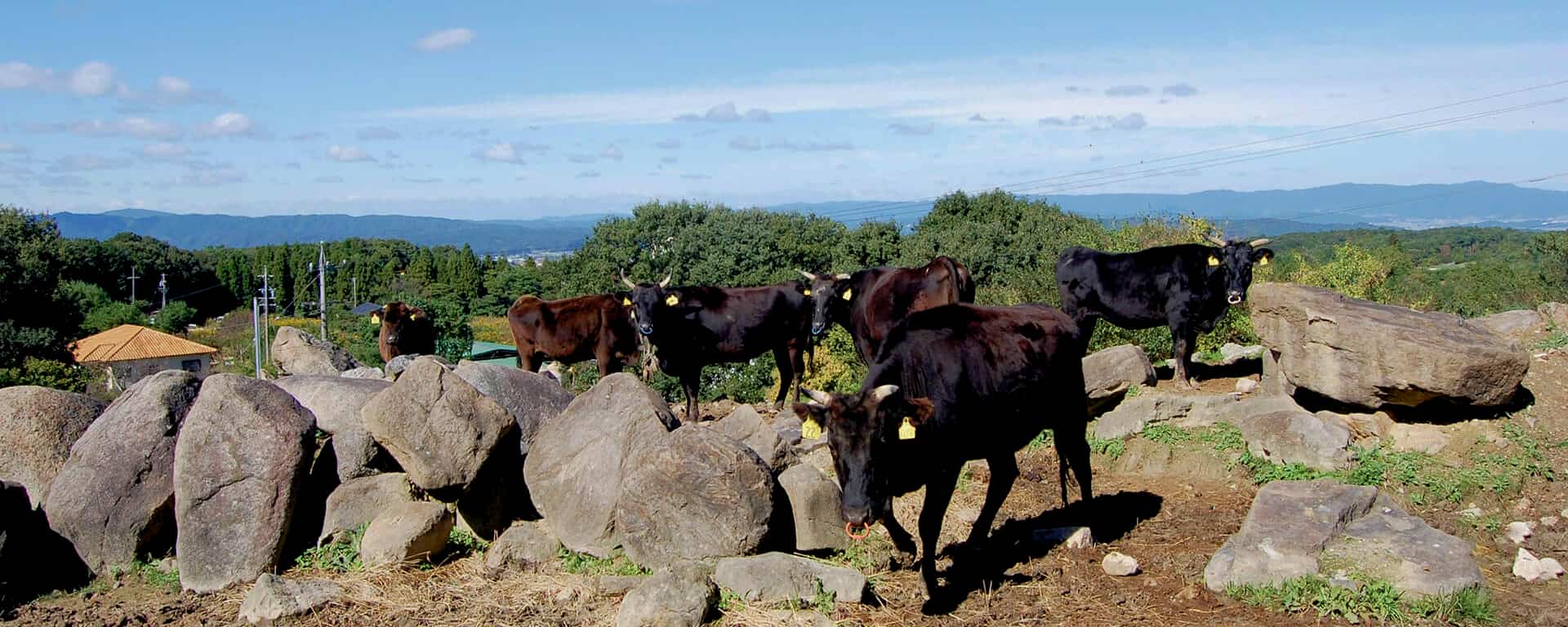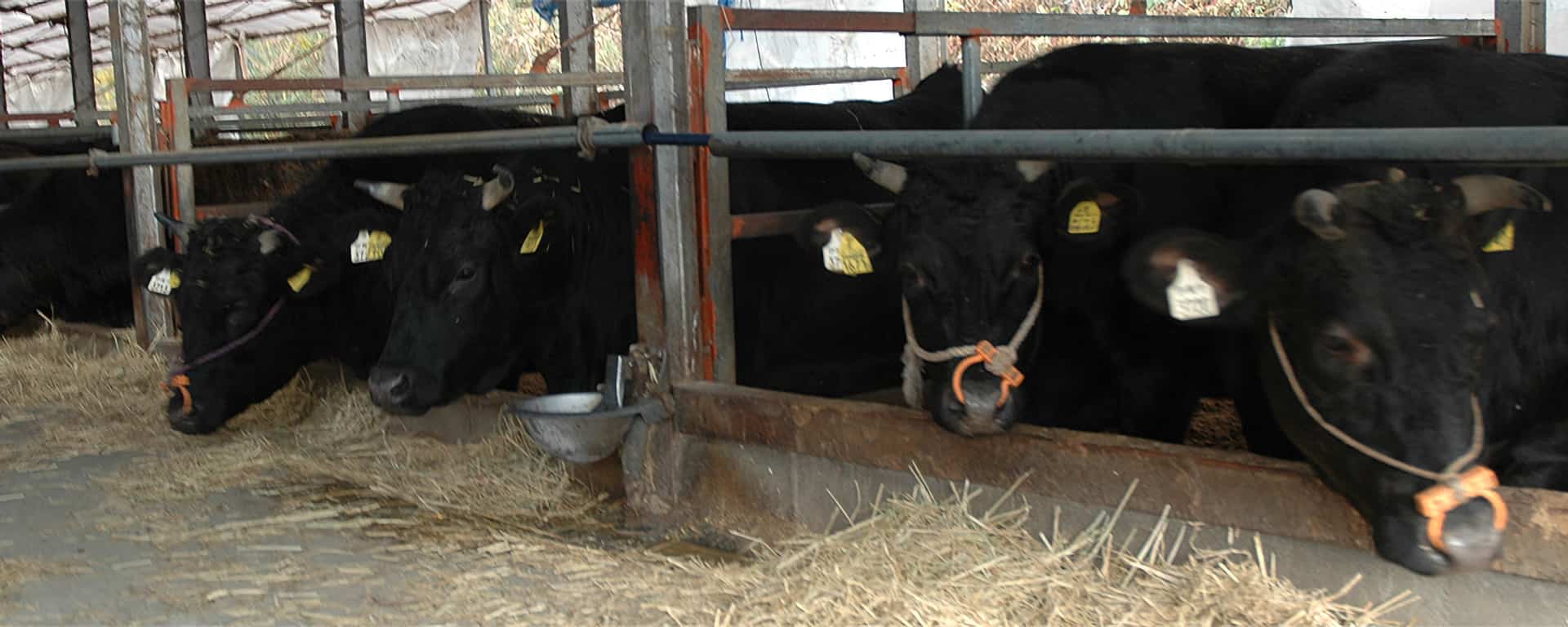
Even at first sight, Wagyu beef is different.
If you come across a Wagyu steak at the supermarket, you’ll notice that it is light pink and filled with white flecks.
These visible layers of white are the marbling naturally produced by Wagyu cattle. Wagyu beef’s intensive marbling surpasses that of other beef — Prime label beef tops out where Wagyu beef begins. It requires a special kind of genetic makeup, and a lifetime of eating the best grains and cozy barns.
An Introduction to Marbling
First off, what’s marbling exactly?
Marbling is the white intramuscular fat found in beef. When butchered, the slab of meat may look dull and dark red. This is characteristic of ordinary cattle.
Or the beef could have white streaks running through it. That white web is the marbling; fat that has developed within the muscle.

The genetics of Wagyu cattle make it predisposed to produce fat — up to 40 percent of good fat content in its beef. This superior marbling cannot be reproduced in other cattle. Even if the cows were raised side by side, at some point in time the ordinary cow will stop producing fat, while the Wagyu cow continues to produce more.
The reason cheap beef turns out flaky and rubbery is due to this lack of marbling. To tenderize it, the meat is marinated in acids and salt, and/or pounded with a mallet. To make the beef buttery, cooks would use, well, a knob of butter. It’ll be melting on top of the steak when served.
When it comes to Wagyu beef, all this seasoning isn’t necessary. In fact Wagyu beef is best enjoyed with its own buttery marbling dissolving into its meat and cooked medium rare.
Marbling Scoring
A beef grader’s job description involves checking cow carcasses for its quality. This meat expert examines how much marbling is present, among other things. In Japan, it takes up to three years of training before the Japan Meat Grading Association considers someone qualified to rate Wagyu beef. There’s technology involved, too. Only now in 2021, for the first time, beef carcasses are able to be assessed across the full spectrum of 0 to 9+ marbling scores by objective grading cameras known as the Meat Image Japan (MIJ-30).
In Australia, this marbling system is known as the AUS-MEAT and Meat Standards Australia (MS for short). When you browse Australian Wagyu beef at the supermarket, you’ll see information like “Striploin MS 5/6” or “Tenderloin MS 7/8”. This tells you the beef’s cut and its marbling score.
Japan’s system is known as the Beef Marbling Standards (BMS). Its grading is actually identical to the Australian MS. So an MS 6 in Australia is the same as a BMS 6 in Japan.

However, the highest BMS grade is 12, which can only be achieved by Wagyu cattle raised in Japan. Australian Wagyu beef tops out at MS 9. Anything above a 9 in Australia is graded as 9+.
You know how we obsess over school grades because that straight A student seems to be on another level?
Wagyu top scorers are the same.
Why Japan Tops the Charts
Since the 1970s, Japan has considered Wagyu cattle to be a national treasure. To preserve its unique progeny, the Japanese government has banned Wagyu cattle from being exported. It’s such serious business that the agricultural ministry proposed a new law in 2020 to penalize the smuggling of Wagyu genetic materials such as fertilized eggs and semen.

While some fullblood Wagyu cattle have made their way to Australia and America in the past, the local environments and production methods have yielded different grades of marbling and flavours. So far, ranchers outside Japan haven’t been able to produce anything above a 9.
In Japan, the Japan Meat Grading Association (JMGA) grades Wagyu beef in 15 stages for yield and quality.
The yield grade assesses the ratio of meat to carcass weight, and is classified into three grades (A: 72% and above, B: 69% and above, C: 69% and below) according to numbers in four categories: ribeye, rib thickness, subcutaneous fat thickness and chilled carcass weight. This part of inspecting meat carcasses hanging from hooks is likely only fully appreciated by the beef auditors.
The quality grade is the part Wagyu consumers may find more fascinating.
Quality is classified into grades (from 1 to 5) according to the following:
- Abundance of marbling: Japan’s Beef Marbling Score famously goes all the way up to 12.
- Meat color and brightness: The Beef Color Standard (BCS) judges the redness of the meat.
- Firmness and texture of meat: A top 5 grade beef has very good firmness and very fine texture.
- Colour, luster and quality of fat: The snowy white fat gets its approval from the Beef Fat Standard (BFS).
To obtain an A5 for the best grade Wagyu beef, there must be a yield of 72% and above, and the BMS must be between 8 and 12 in addition to top ratings for all other areas.
Buy A5 Wagyu Beef
Our insight comes from Wagyu farms in Iga, the birthplace of the Iga-ryu ninja. In this mountainous region, the Iga Beef Cattle Production Promotion Council manages a legendary breed of black-haired cattle that produce Iga Beef, one of the most premium A5 Wagyu beef.
For Wagyu connoisseurs, Iga Beef offers rich, caramel-like flavors without any gamey or greasy taste. We import Iga Beef because our customers say it suits Malaysian palates best.
Need any help?
Got a question about our Wagyu beef? We’re always happy to hear from our customers! Visit our online store or contact us directly for the latest stock and promotion!